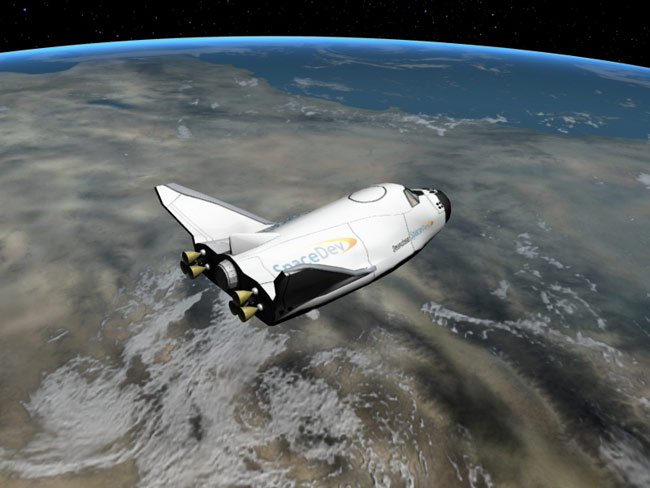Moon Tourism by 2020, Entrepreneurs Predict

Leading space entrepreneurs said they are ready, willing andable to fill the U.S. spaceflight gap after NASA retires its space shuttlesthis year.
They confidently predicted that commercialspaceships could fly both cargo and humans into low-Earth orbit for lowercost and by about 2014, or at least several years sooner, than NASA's originalplan based on the now-canceled Constellation program.
The space industry executives hailed the Obamaadministration's proposal to devote $6 billion over the next five years towardcommercial spaceflight. It opens the door for potential trips to the moon oncommercial vehicles, they added.
That "historic decision" could create an estimated5,000 jobs in the United States and help NASA avoid paying billions of dollarsto Russia for rides to the space station, said Bretton Alexander, president ofthe Commercial Spaceflight Federation, during a Monday teleconference.
Still, Alexander and others took time to address one of themain doubts in the minds of critics ? whether commercial spaceflight canprovide safeaccess to space.
Safety first
Some critics and members of Congress have expressed theirown concerns about the safety of untried commercial spaceflight.
Get the Space.com Newsletter
Breaking space news, the latest updates on rocket launches, skywatching events and more!
But space industry executives said safety is of the utmostimportance to them.
Elon Musk, founder of the commercial spaceflight ventureSpace Exploration Technologies (SpaceX), likened the issue to how airlinetravelers fly today on Southwest Airlines or Virgin America without a secondthought because safety has become a universal standard for airlines. He andother space entrepreneurs said that they too must hold to the highest safetystandards lest they lose out to competitors.
"Safety-wise, we are the least able to affordmishaps," said Robert Bigelow, head of the Las Vegas, Nev.-based firmBigelow Aerospace, which is building inflatablespace habitats and has already launched two prototypes.
By contrast, he said that NASA's government program has beenable to shrug off disasters more easily throughout its history.
The space industry firms represented in the teleconferencehave all aimed for the highest human safety standards set by NASA or Russia'sSoyuz program ? the latter arguably having a better track record than the spaceshuttle, they said. Since shuttle flights began in 1981, NASA has suffered twodisasters that have killed 14 astronauts.
"I think that for people to say that we here in theU.S. have done a great job on safety with the old way is just wrong," saidcomputer game developer and entrepreneur Richard Garriott, who paid $30 millionto fly to the International Space Station aboard a Soyuz as a spacetourist.
That spacecraft, he said, has a "100-folddifference" in its safety record compared to the space shuttle. Garriottis also the son of former NASA astronaut Owen Garriott, who flew on the Skylabspace station and an early space shuttle flight.
SpaceX and its competitors touted that, with appropriatefunding, they could start flying U.S. astronauts into space around 2014. Itwould cost less than NASA pays to fly astronauts aboard Russia's Soyuz craft tothe space station.
NASA currently pays about $51 million a seat to sendastronauts to space on Russian spacecraft. But first the companies want toestablish a safety record with many unmanned launches.
Moon or Mars in the next decade
The space entrepreneurs all painted an optimistic picture ofhow commercial spaceflight could look by the year 2020. They envisioned anumber of companies providing commercial crew transport to low-Earth orbit, anda "really well-used ISS" that is taken advantage of as a governmentlab, according to Musk of SpaceX.
Bigelow noted that his space hotel company plans to pursuean "aggressive schedule" that would launch several private spacestations within the next decade.
But the group also looked forward to commercial spaceflightbeyond the confines of low-Earth orbit.
"By 2020 you'll have seen private citizenscircumnavigate the moon," said Eric Anderson of Space Adventures, the onlycompany currently selling space tourist flights to orbit.
If that still sounds dreamy, consider that Space Adventuresis offering trips around the moon aboard Russian-built Soyuz spacecraft for $100million per ride.
Commercial spaceflight could even realize one of the mostcherished dreams of humans setting foot on another planet, if the spaceindustry drives down costs and boosts innovation hand-in-hand with NASA.
"I'm going to go out on a limb and say that by 2020there will be serious plans to go to Mars with people," Musk said.
Editor's note: This story has been corrected to reflectthat space tourism firm Space Adventures has not yet booked a private moonflight, but is still offering the service to potential customers.
- Obama Budget Scraps NASA Moon Plan for '21st Century Space Program'
- Video Show - This Week in Space: Lockheed vs. SpaceX
- Just 5 Missions Left for NASA's Space Shuttles
Join our Space Forums to keep talking space on the latest missions, night sky and more! And if you have a news tip, correction or comment, let us know at: community@space.com.
Jeremy Hsu is science writer based in New York City whose work has appeared in Scientific American, Discovery Magazine, Backchannel, Wired.com and IEEE Spectrum, among others. He joined the Space.com and Live Science teams in 2010 as a Senior Writer and is currently the Editor-in-Chief of Indicate Media. Jeremy studied history and sociology of science at the University of Pennsylvania, and earned a master's degree in journalism from the NYU Science, Health and Environmental Reporting Program. You can find Jeremy's latest project on Twitter.









